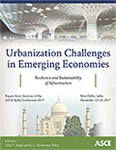ASCE India Conference 2017
Development of Earthquake Readiness Index Tool to Assess Individual Earthquake Preparedness Level
Publication: Urbanization Challenges in Emerging Economies: Resilience and Sustainability of Infrastructure
ABSTRACT
The seismic risk level is high in India in context of potential future earthquakes and high population density. The worldwide experiences have shown that distressing effects of earthquakes can be effectively reduced by improving the earthquake preparedness level of individuals. The governing bodies and non-governmental agencies can assess and improve preparedness periodically, only if there is measurement tool to assess the preparedness levels. This study aims at the development of such a reliable and valid survey-based tool that can measure individual preparedness level in terms of earthquake readiness index (ERI). The tool was developed through a three-phase process including literature surveys, questionnaire development involving pilot studies, validity and reliability checks, and field investigation. Content validity, construct validity, internal consistency check using Cronbach’s alpha coefficient, test-retest reliability check using Spearman’s correlation exploratory factor analysis, and confirmatory factor analysis were carried out for the developing the ERI measuring survey tool. Study on Indian residents with samples collected from the city of Coimbatore from 540 respondents, confirmed the factor analysis. The final 27-item tool consisted of six categories like emergency needs, personal safety, outdoor safety, indoor safety, structural safety, and mitigation.
Get full access to this article
View all available purchase options and get full access to this chapter.
REFERENCES
Anbazhagan, P., Gajawada, P., Parihar, A. (2011). “Seismic hazard map of Coimbatore using subsurface fault rupture.” Nat. Hazards., 60, 1325-1345.
Col, J. M. (2007). “Managing disasters: The role of local government.” Public administration review, 67(s1), 114-124.
CRED, UNISDR (2015). “The human cost of weather-related disasters, 1995-2015.” United Nations, Geneva
Earthquake Commission. (2011). “Monitoring the effectiveness of the Earthquake Commission’s communication programme: quarter 2 2011”. Earthquake Commission, Wellington.
Guha-Sapir, D., Hoyois, Ph., Below, R. (2016). “Annual Disaster Statistical Review 2016: The Numbers and Trends.” Brussels: CRED
ISDR, U. (2005). “Hyogo framework for action 2005-2015: building the resilience of nations and communities to disasters”. In Extract from the final report of the World Conference on Disaster Reduction (A/CONF. 206/6) (Vol. 380)
Iyengar, R. N., et al. (2010). “Development of probabilistic seismic hazard map of India.” Technical report of the Working Committee of Experts (WCE) constituted by the National Disaster Management Authority. New Delhi: Govt. of India.
Joffe, H., Perez-Fuentes, G., Potts, H. W., & Rossetto, T. (2016). “How to increase earthquake and home fire preparedness: the fix-it intervention.” Natural Hazards, 84(3), 1943-1965.
Kolathayar, S., Sitharam, T. G., & Vipin, K. S. (2012). Deterministic seismic hazard macrozonation of India. Journal of Earth System Sciences, 121(5), 1351-1364.
Nath, S. K., & Thingbaijam, K. K. S. (2012). “Probabilistic seismic hazard assessment of India.” Seismological Research Letters, 83(1), 135-149
Okazaki, K., Ilki, A., Ahmad, N., Kandel, R.C., and Rahayu, H. (2008). “Seismic Risk Perception of People for Safer Housing.” Proc., 14th World Conf. on Earthquake Engineering, Beijing.
O’Leary, M. (2004). The first 72 hours: A community approach to disaster preparedness. iUniverse.
Prakash, E.L., Kolathayar, S., Ramkrishnan, R. (2018). “Seismic Risk Assessment for Coimbatore Integrating Seismic Hazard and Land Use.” In: Farid, A., Chen, H. (eds) Proceedings of GeoShanghai 2018 International Conference: Geoenvironment and Geohazard. GSIC 2018. Springer, Singapore
Sitharam, T. G., & Kolathayar, S. (2013). “Seismic hazard analysis of India using areal sources.” Journal of Asian Earth Sciences, 62, 647-653.
Sitharam, T. G., Kolathayar, S., & James, N. (2015). Probabilistic assessment of surface level seismic hazard in India using a topographic gradient as a proxy for site condition. Geoscience Frontiers, 6(6), 847-859.
Spittal, M.J., Mc Clure, J., Siegert, R.J., Walkey, F.H., and Ballantyne, K.E. (2006). “The Earthquake Readiness Scale: The Development of a Valid and Reliable Unifactorial Measure.” Nat. Hazards., 39, 15-29.
Information & Authors
Information
Published In
Urbanization Challenges in Emerging Economies: Resilience and Sustainability of Infrastructure
Pages: 149 - 155
Editors: Udai P. Singh and G. L. Sivakumar Babu, Indian Institute of Science
ISBN (Online): 978-0-7844-8203-2
Copyright
© 2018 American Society of Civil Engineers.
History
Published online: Dec 13, 2018
Published in print: Dec 13, 2018
Authors
Metrics & Citations
Metrics
Citations
Download citation
If you have the appropriate software installed, you can download article citation data to the citation manager of your choice. Simply select your manager software from the list below and click Download.
